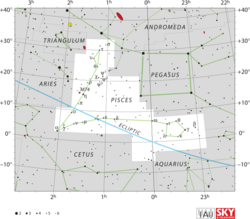Astronomy:Delta Piscium
| Observation data Equinox J2000.0]] (ICRS) | |
|---|---|
| Constellation | Pisces |
| Right ascension | 00h 48m 40.94433s[1] |
| Declination | +07° 35′ 06.2926″[1] |
| Apparent magnitude (V) | +4.416[2] |
| Characteristics | |
| Spectral type | K4 IIIb[3] |
| U−B color index | +1.831[2] |
| B−V color index | +1.500[2] |
| Astrometry | |
| Radial velocity (Rv) | +32.45±0.18[4] km/s |
| Proper motion (μ) | RA: +83.10[1] mas/yr Dec.: −49.58[1] mas/yr |
| Parallax (π) | 10.48 ± 0.22[1] mas |
| Distance | 311 ± 7 ly (95 ± 2 pc) |
| Absolute magnitude (MV) | −0.46[5] |
| Details[4] | |
| Mass | 1.65[3] M☉ |
| Radius | 44 R☉ |
| Luminosity | 447 L☉ |
| Surface gravity (log g) | 1.0 cgs |
| Temperature | 3,963±4 K |
| Metallicity [Fe/H] | −0.20 dex |
| Rotational velocity (v sin i) | 5.5 km/s |
| Age | 2.98[3] Myr |
| Other designations | |
| Database references | |
| SIMBAD | data |
Delta Piscium (δ Piscium) is a solitary,[7] orange-hued star in the zodiac constellation of Pisces. It has an apparent visual magnitude of +4.4,[2] so it is bright enough to be faintly visible to the naked eye. Based upon an annual parallax shift of 10.5 mas, it is around 311 light-years (95 parsecs) from the Sun.[6] The visual magnitude of the star is diminished by an interstellar absorption factor of 0.08 due to interstellar dust.[8]
This is an evolved K-type giant star with a stellar classification of K4 IIIb.[3] It has around 1.65 times the mass of the Sun and, at the age of three billion years,[3] has expanded to 44[4] times the Sun's radius. The star is radiating 447 times the Sun's luminosity from its enlarged photosphere at an effective temperature of 3,963 K.[4]
Because Delta Piscium is positioned near the ecliptic, so it is subject to lunar occultations.[9] It has a magnitude 13.99 visual companion at an angular separation of 135.0 arc seconds on a position angle of 12°, as of 2011.[10]
Naming
In Chinese, 外屏 (Wài Píng), meaning Outer Fence, refers to an asterism of stars, δ Piscium, ε Piscium, ζ Piscium, μ Piscium, ν Piscium, ξ Piscium and α Piscium. Consequently, the Chinese name for δ Piscium itself is 外屏一 (Wài Píng yī, English: the First Star of Outer Fence.)[11]
References
- ↑ 1.0 1.1 1.2 1.3 1.4 van Leeuwen, F. (2007), "Validation of the new Hipparcos reduction", Astronomy and Astrophysics 474 (2): 653–664, doi:10.1051/0004-6361:20078357, Bibcode: 2007A&A...474..653V.
- ↑ 2.0 2.1 2.2 2.3 Cousins, A. W. J. (1984), "Standardisation of broad band photometry of equatorial standards", South Africa Astronomical Observatory Circular 8: 59–67, Bibcode: 1984SAAOC...8...59C.
- ↑ 3.0 3.1 3.2 3.3 3.4 Luck, R. Earle (2015), "Abundances in the Local Region. I. G and K Giants", The Astronomical Journal 150 (3): 88, doi:10.1088/0004-6256/150/3/88, Bibcode: 2015AJ....150...88L.
- ↑ 4.0 4.1 4.2 4.3 Massarotti, Alessandro et al. (January 2008), "Rotational and radial velocities for a sample of 761 HIPPARCOS giants and the role of binarity", The Astronomical Journal 135 (1): 209–231, doi:10.1088/0004-6256/135/1/209, Bibcode: 2008AJ....135..209M.
- ↑ Anderson, E.; Francis, Ch. (2012), "XHIP: An extended hipparcos compilation", Astronomy Letters 38 (5): 331, doi:10.1134/S1063773712050015, Bibcode: 2012AstL...38..331A.
- ↑ 6.0 6.1 "del Psc". SIMBAD. Centre de données astronomiques de Strasbourg. http://simbad.u-strasbg.fr/simbad/sim-basic?Ident=del+Psc.
- ↑ Eggleton, P. P.; Tokovinin, A. A. (September 2008), "A catalogue of multiplicity among bright stellar systems", Monthly Notices of the Royal Astronomical Society 389 (2): 869–879, doi:10.1111/j.1365-2966.2008.13596.x, Bibcode: 2008MNRAS.389..869E.
- ↑ Famaey, B. et al. (2005), "Local kinematics of K and M giants from CORAVEL/Hipparcos/Tycho-2 data. Revisiting the concept of superclusters", Astronomy and Astrophysics 430: 165–186, doi:10.1051/0004-6361:20041272, Bibcode: 2005A&A...430..165F.
- ↑ Meyer, C. et al. (1995), "Observations of lunar occultations at Observatoire de la Cote d'Azur", Astronomy and Astrophysics Supplement 110: 107, Bibcode: 1995A&AS..110..107M.
- ↑ Mason, B. D. et al. (2014), "The Washington Visual Double Star Catalog", The Astronomical Journal 122 (6): 3466–3471, doi:10.1086/323920, Bibcode: 2001AJ....122.3466M, http://vizier.u-strasbg.fr/viz-bin/VizieR?-source=B/wds, retrieved 2015-07-22
- ↑ (in Chinese) AEEA (Activities of Exhibition and Education in Astronomy) 天文教育資訊網 2006 年 5 月 19 日
External links
- Kaler, James B. (January 6, 2012), "DELTA PSC (Delta Piscium)", STARS (University of Illinois), http://stars.astro.illinois.edu/sow/deltapsc.html, retrieved 2017-08-02.
 |


